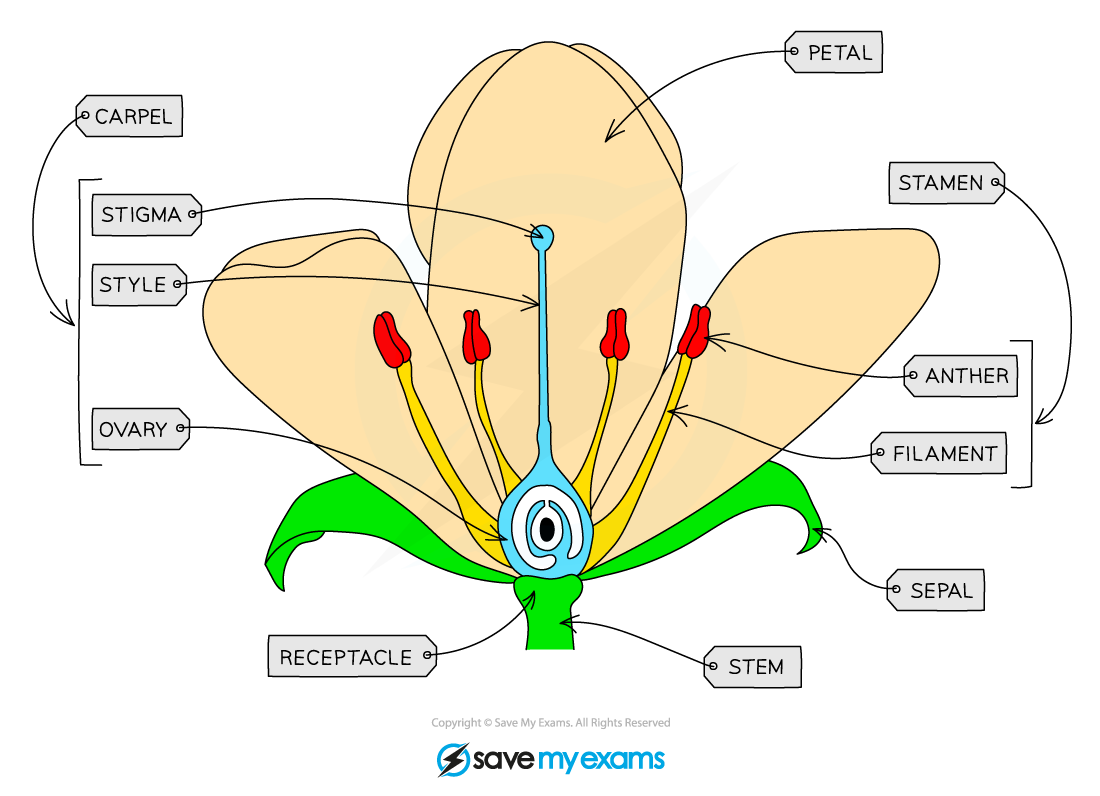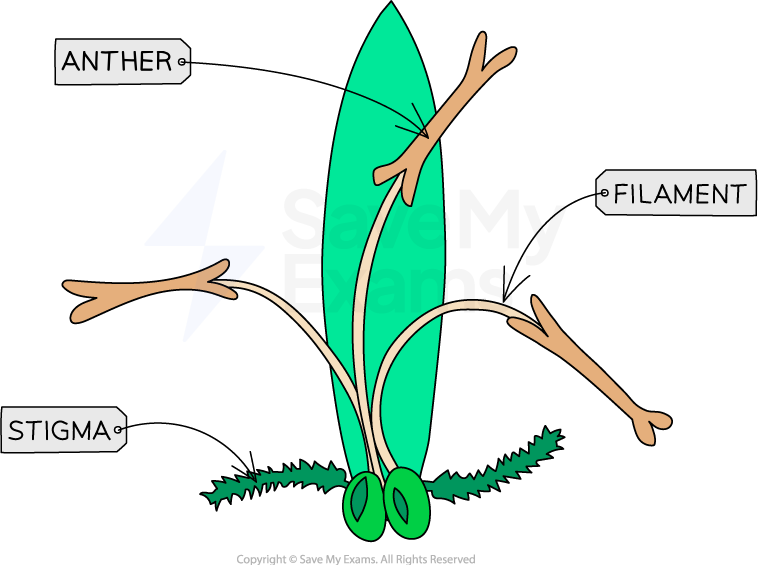Reproduction In Plants
1/5
There's no tags or description
Looks like no tags are added yet.
Name | Mastery | Learn | Test | Matching | Spaced |
|---|
No study sessions yet.
6 Terms
What is the structure of an insect-pollinated flower and how is it adapted for pollination?
Insect-Pollinated Flowers
Flowers are the reproductive organs of plants
The role of flowers is to enable plant gametes to come together in fertilisation
The male gametes of plants are found in pollen grains
The female gametes of plants are in ovules
The process by which pollen is transferred from the male part of a flower to the female part of a flower is known as pollination; this can be carried out in various ways, e.g. by insects or by wind
Insect-pollinated flower structure

Insect pollinated flowers are adapted to attract insects and aid insect pollination
Structure | Description |
Sepal | Protects unopened flower |
Petals | Brightly coloured in insect-pollinated flowers to attract insects |
Anther | Produces and releases pollen |
Filaments | Provides support to the anther |
Stigma | Sticky top of the female part of the flower which collects pollen grains |
Style | A tube that connects the stigma and ovary |
Ovary | Contains the ovules |
Ovule | Structures inside the ovary that contain the female gametes |
Structural adaptations of insect-pollinated flowers
Insect pollinated flowers are adapted to allow insects to collect pollen from one flower and easily transfer it to another flower
When an insect enters a flower in search of nectar it brushes against the anthers, which deposit sticky pollen onto the insect's body
When the insect visits another flower it brushes against the stigma and deposits some of the pollen from the first flower; this is pollination
Feature | Adaptations of an insect pollinated flower |
Petals | Large and brightly coloured to attract insects |
Scent and nectar | Scent and nectar are produced to encourage insects to visit the flower and push past stamen to get to nectar |
Anthers | Held on stiff filaments within the flower so that they brush against insects |
Stigma | Sticky stigmas within the flowers catch pollen grains when insects brush past |
What is the structure of an wind-pollinated flower and how is it adapted for pollination?
Wind-Pollinated Flowers
Wind pollinated flower structure
Wind-pollinated flowers do not need to attract insects, so their structure differs from that of insect-pollinated flowers

Wind pollinated flowers have anthers that hang outside the flower on long filaments, and feathery stigmas that can catch pollen easily
Structural adaptations of wind-pollinated flowers
Wind pollinated flowers are adapted so that wind can easily catch pollen grains and carry them to the stigmas of other flowers
The anthers and stigmas of wind pollinated flowers hang outside the flower so that:
pollen can easily be blown away by the wind
pollen can easily be caught by the stigmas of other flowers
Feature | Adaptations of a wind pollinated flower |
Petals | Small and dull, often green or brown in colour; producing colourful petals would be a waste of energy |
Scent and nectar | Scent and nectar are not produced; this would be a waste of energy |
Anthers | Held on long filaments outside the flower to release pollen grains easily into the wind |
Stigma | Feathery stigmas outside the flower catch airborne pollen grains |
What is the process that leads to seed and fruit formation?
Fertilisation
After successful pollination a pollen tube forms to deliver the male nucleus to the egg cell, or ovum, in the ovary of a flower
The pollen tube grows down the style towards the ovary
The pollen grain travels down the pollen tube
Fertilisation occurs when the pollen nucleus and the ovum nucleus fuse together to form a zygote

The pollen nucleus travels down a pollen tube before fusing with a female nucleus during fertilisation
Seed and fruit formation
After fertilisation, the ovule (that contains the zygote) develops into the seed
The wall of the ovule develops into the seed coat, known as the testa
The parts of the flower surrounding the ovule (mainly the ovary walls) develop into the fruit, which contains the seeds
The fruit provides a mechanism for seed dispersal (getting the seeds away from the parent plant)
Some fruits are eaten by animals, which then disperse the seeds in their droppings (the tough outer coat of seeds stops them from being digested)
Some other fruits have sticky hooks that get caught in the fur of passing animals
As different plants have different numbers of ovules, this explains why different fruits have different numbers of seeds (which develop from the ovules)
Part of flower | Becomes |
Zygote | Embryonic plant (radicle & plumule) |
Ovule | Food store in seed |
Ovule wall | Seed coat (testa) |
Ovary wall | Fruit coat (fleshy part) |
Describe a practical to investigate the conditions needed for seed germination?
Practical: Conditions for Germination
Germination marks the beginning of seed growth
Three key factors are needed for successful germination:
Water: swells the seed, breaks the seed coat, and activates enzymes for growth
Oxygen: necessary for respiration to provide energy
Warmth: boosts enzyme activity and improves germination until a certain temperature
Carbon dioxide has no effect on germination
Apparatus
Test tubes
Test tube holder
Cress seeds
Cotton wool
Fridge
Method
Prepare 4 test tubes with 10 cress seeds on cotton wool, labeled A, B, C, and D
Tube A: Keep the cotton wool dry
Tube B: Moisten the cotton wool with water
Tube C: Cover the seeds and cotton wool with water and add a layer of oil on top
Tube D: Moisten the cotton wool and place the tube in a fridge (~4°C)
Keep tubes A, B, and C at room temperature or around 20°C
After 3-5 days, ensure the cotton wool in tubes B and D stays moist
Compare the number of germinated seeds in each tube

Conditions required for germination: how to set up the experiment
Results and Analysis
The test tubes are set up to test the necessity of water, oxygen, and warmth for germination by removing each factor in turn:
Tube A: Water is absent
Tube B: Control, all factors present
Tube C: Oxygen is blocked by oil and water layers
Tube D: Warmth is removed by refrigeration
As germination requires all three factors, only the seeds in the control tube (B) are expected to germinate
Conditions required for germination: Example results table

Applying CORMS to practical work
When working with practical investigations, remember to consider your CORMS evaluation

CORMS evaluation
In this investigation, your evaluation should look something like this:
C - We are changing the abiotic conditions in which the seeds are germinating
O - The cress seeds will all be taken from the same parent plant (or at least from the same species of cress plant)
R - We will repeat the investigation several times to ensure our results are reliable
M1 - We will record how many seeds in each test tube germinate
M2 - ...after a set time period (e.g. 3 days)
S - We will control the temperature for tubes A, B and C. We will also control the type of water used (i.e. sterile water, which is made by first boiling then cooling water)
How do germinating seeds utilise food reserves until the seedling can carry out photosynthesis?
Germination
Germination is the beginning of seed growth
The seed contains a zygote that develops into the embryo
During germination, the embryo grows into a seedling
Cotyledons surround the embryo, storing food for the seedling
Some plants have one cotyledon, others have two
Cotyledons provide energy until the plant can photosynthesize
Water absorption splits the seed coat (testa), allowing the plumule (first emerging shoot) and radicle (first emerging root) to emerge

The structures of a germinating seed
How can plants reproduce asexually by natural methods and by artificial methods?
Asexual Reproduction in Plants
Plants can reproduce asexually as well as sexually
Asexual reproduction only involves one parent and all offspring produced are exact genetic copies of each other and the parent plant – they are clones (genetically identical)
Asexual reproduction in plants can occur naturally or humans can control asexual reproduction in plants artificially for their own uses
Natural asexual reproduction in plants – runners
Some plants grow side branches, known as runners, that have small plantlets at their ends
Runners are horizontal stems that grow sideways out of the parent plant
Once they touch the soil, these plantlets will grow roots and the new plantlets will grow and become independent from the parent plant

Some plants grow side shoots called runners that contain tiny plantlets on them. These will grow roots and develop into separate plants.
Artificial asexual reproduction in plants – cuttings
A simple method to clone plants (mainly used by gardeners) is by taking cuttings
This is an artificial method of asexual reproduction
The method for taking cuttings is as follows:
Gardeners take cuttings from good parent plants (i.e. those that are healthiest and best-looking)
A section of the parent plant with a new bud is cut off
This cutting can either be placed into water until new roots grow or can sometimes be placed directly into soil
Sometimes, the stem of the cutting may first be dipped into 'rooting powder', which contains plant growth regulators (rooting hormones) that encourage new root growth
These cuttings are then planted and eventually grow into adult plants that are genetically identical to the original plant
Plants cloned by taking cuttings can be produced cheaply and quickly

Artificial asexual reproduction in plants – cuttings